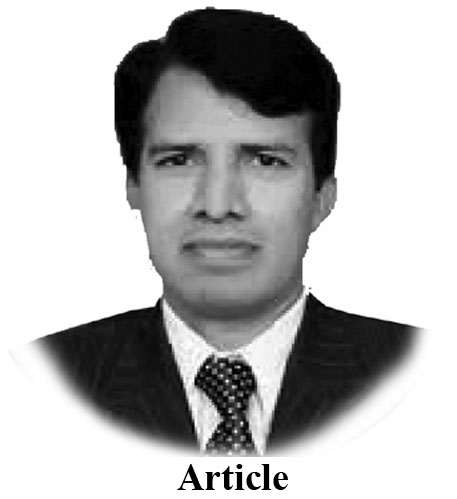Dr Muhammad Khan
THE law makers of India must have worked well while altering the status of Jammu and Kashmir from a disputed state to union territories of India, before introducing it to Indian Parliament on 5 August 2019. The legal team of Prime Minister Modi has been working well for years to take this extreme step, but they were not finding a legal way-out to make occupied Jammu and Kashmir as an integral part of Indian Union. This legal team even tried to dilute Article 35-A of Indian Constitution through Indian Supreme Court, but failed to make a headway. Through this dilution, India wanted to change the demographic factor of the state which could have subsequently paved way for undoing Article 370. Indeed, the strong and continuance Kashmiri resistance in the IoK did not let India and its 700,000 security forces change its status. Failing on all legal fronts, India took extreme step of introducing and passage of ‘The Jammu and Kashmir Reorganisation Act-2019, on 5 August 2019. This lawless law was passed by both houses of the Indian Parliament on 5 and 6 August and subsequently signed by Indian President, Ram Nath Kovind, on 9 August, making it an Act (part of Indian Constitution). On the legal basis, it is a serious violation of the Indian Constitution, the Constitution of occupied Jammu and Kashmir and above all, a violation of all UN resolutions on Kashmir (UNSC-91 and UNSC-122). Since it was drafted secretly, therefore, the due process, legally and democratically needed for the constitutional amendment was not followed by Indian Government, making it a black law in the history of Indian constitutional history.
Indeed, ‘The Jammu and Kashmir Reorganisation Act-2019, was passed hurriedly by both Houses of Indian Parliament, while imposing curfew and siege throughout the state with additional deployment of Indian troops, taking the number to 900,000 security forces in IoK. This all speaks of Indian designs of forceful reoccupation of the state of Jammu and Kashmir on 5 August 2019, after it revoked the special status of the state, a temporary arrangement, state had with India. Earlier, India occupied the state on 27 October 1947 through a military invasion, taking excuse of so-called instrument of accession. The term Union Territory means an administrative division within the geographical territory of a state, so far specific to India. It is worth mentioning that, there was no concept of union territories in the original version of Indian Constitution. It was included in the Indian constitution in 1956 through 7th Amendment Act and applicable to integral Indian territories only. The state of Jammu and Kashmir is not part of Indian Union, then how can India extend its jurisdiction over it as Union Territory. Even in Article 370, the relationship between Kashmir and Indian Union was temporary, transitional and provisional. This was an article applicable until, Kashmiri decide their fate through a fair and impartial plebiscite under UN as per UN resolutions. India had accepted these UN resolutions.
“The concept of a ‘Union Territory’ is unique to India” and included those territories which were small enough to be given the status of a state or province. The governing factor for the Union Territories in India is a smaller territory which otherwise unable to administer itself; ‘economically, politically, socially, culturally, geographically and may be on security basis.’ Even not being part of Indian Union, the state of Jammu and Kashmir has been strong in administering itself in all aspects mentioned above. Therefore, changing the status of the State of Jammu and Kashmir from one integrated separate State to ‘Union Territories’ of India (Union territories of Jammu and Kashmir, and Ladakh) is illegal and unlawful. In a way, there is a relegation of the state from the status, it traditionally enjoyed for centuries, even during the time of occupation under various rulers including 72 years of Indian rule over IoK. By disintegrating the state into two parts and lowering its status, India has indeed, demeaned the entire Kashmiri nation. Furthermore, while still maintaining Presidential Rule, India appointed a Lieutenant Governor for the two territories of Kashmir which refreshed the reminiscence of colonialism, India had under British rule. By doing so, India has converted the state subjects of the state into hostage, directly controlled by New Delhi.
Presidential Rule is a direct rule by New Delhi for the strict control measures, practiced during British era. Jammu and Kashmir Reorganization Act-2019, has 103 clauses; it has amended 106 central laws related to IoK besides repealing over 150 state laws, all done in violation of India’s own constitution and constitution of IoK. India was preparing for this all since 2014 and had taken the extreme step once it imposed Governor Rule, later converted into Presidential Rule in 2018. From the legal perspective, converting the state of Jammu and Kashmir from an established separate State to Indian Union is a serious violation of international law, Indian constitution, UN resolutions and above all UN Charter, which govern the concept of nation state. This all has been done against the wishes of the state subjects of the IoK, who are still under siege and curfew, imposed since August 5, 2019. The UN and world must realize their global responsibilities in the light of Responsibility to Protect (R2P) and Liberal Interventionist Approach of International Relations. R2P was universally endorsed at the 2005 World Summit and then re-affirmed in 2006 by UN.
— The writer, a retired Brig, is Professor of Politics and International Relations at International Islamic University, Islamabad.










